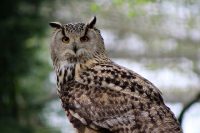Long-eared owls (Asia Otus) occur in North America, Asia and Europe. They belong to the family of true owls. It is a medium-sized bird. It has orange eyes and visibly black tufts of feather on its head. Its plumage is black-to-brownish in color and contains dark brown vertical streaks.
Long-eared owls are 31 to 40 centimeters long and have a wingspan of 86 to 100 centimeters. It weighs around 178 to 435 grams. Males are smaller than the female owls.
In the wild, long-eared owls have a lifespan of around 27 years.
It starts breeding in February and up to July. These owls reach maturity after 1 year.
It lays a clutch size of 4 to 6 eggs. A female owl incubates for 25 to 30 days. After around 35 days, the chicks begin to fly.
female owl incubates for 25 to 30 days. After around 35 days, the chicks begin to fly.
They are distributed widely across Eurasia, Northern United States and North Africa. The U.S. is home to about 6,000 of these owls.
These owls nest on the crevices of mostly coniferous trees. These empty cracks are often left behind by other birds. Long-eared owls occur in dense forests and roost at an altitude of 2,750 meters. In winter, these owls are often found roosting together in a group called “communal roosting”. This group can range from 2 to 20 birds.
Like most owls, the long-eared owl diet primarily consists of small mammals, rodents and birds.
As it senses any danger, long-eared owl makes a series of “ooack-ooack” kind of sounds.
The eggs of Long-eared owls are eaten by raccoons. However, the predators for the adult ones are barred owls and great horned owls.
They have four subspecies.
Other name: Northern Long-eared Owl





